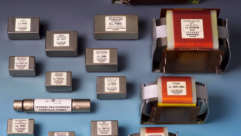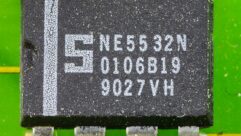
DEALING WITH LONG LINES
Dec 1, 2001 12:00 PM,
BILL WHITLOCK
IN MY OCTOBER 1999 “CLEAN SIGNALS” COLUMN, I talkedabout long lines. In terms of electrical wavelength, a long audio cable(20 kHz bandwidth) was defined as one over about 4000 feet (1200 m),and a long video cable (5 MHz bandwidth) as one over about 15 feet (4.5m).
Such long lines require termination to avoid signal degradation dueto transmission line effects. Cable capacitance and line-driver outputimpedance form a low-pass filter that can significantly degradehigh-frequency response in audio cables over about 100 feet (30 m)long. This is especially true in consumer equipment where outputimpedance is often quite high.
I also mentioned a more subtle current-limiting problem that canoccur when low-impedance, professional, balanced outputs drive longlines. It distorts or clips high-level, high-frequency program materialsuch as cymbal crashes or vocal sibilance. However, none of theseproblems cause noise or interference. But when it comes to noise andinterference, problems are much more likely with long lines, and theseverity will depend on whether the interface is balanced orunbalanced.
Significant ground voltage differences between driver and receiverare almost certain with long signal lines. These ground voltagedifferences are an entirely normal feature of safe, well-designed andcode-compliant electrical power distribution systems. Balanced signalinterfaces are inherently immune to these normal ground voltagedifferences, while unbalanced signal lines are especiallysusceptible.
THE POWER LINE CONNECTION
To get some idea how the power system couples noise into signalinterconnections, take a look at Figure 1. It shows how thewiring between just two pieces of equipment in a system forms aphysically large loop. Although the green safety ground wiring isintended to carry only fault currents from defective equipment, undernormal conditions it carries small leakage currents from everysafety-grounded device, including our system gear, which is powered bythe branch circuit. Leakage currents of several milliamperes per deviceare not uncommon, and accumulated current in the safety ground canreach 100 mA or more.

Because safety ground wiring has resistance like all real-worldconductors, leakage current causes voltage drops, generallydouble-digit millivolts, between outlets on a branch circuit. Voltagesbetween outlet grounds on different branch circuits, especially ifthey’re wired to opposite phases of the utility power feed, can beconsiderably higher — often 100 mV or more. The voltage can reachseveral volts between two outlets in different buildings! This voltageis effectively impressed across the length of the signal interconnectcable. When it couples into the signal path, it is heard as a hum orseen as a slowly upward-creeping disturbance in video displays.
It’s important to realize that similar leakage currents are alsogenerated by equipment without ground connections on their AC powerplugs. Although UL regulations limit leakage from equipment with nosafety ground to 0.75 mA, this amount is still significant. This is thecurrent that causes the tingle sometimes felt when touching equipmentor appliances with 2-prong AC plugs.
In systems using this kind of equipment, the leakage current simplyflows from one device to another through the signal interconnect cable,causing 99% of hum and buzz problems in consumer audio systems. Forexample, consider that the shield conductor of a typical 20-foot RCAcable may have a resistance of 1 ohm. If a leakage current of only 0.3mA flows in it, a 300 microvolt noise voltage will exist between itsends. Because leakage currents are capacitively coupled (effectively ahigh-pass filter), they are most often heard as a buzz when coupledinto the signal path.
UNBALANCED INTERCONNECTS OPEN THE DOOR TO NOISE
The grounded conductor in an unbalanced signal interconnection,usually the shield, carries both signal and the aforementioned noisyleakage current. At the receive end of the cable, the signal from thedriven end and the voltage drop caused by leakage current flow in theshield are simply added together. This is called common-impedancecoupling. In the example above, the noise will be only 60 dB belowa 300 millivolt consumer-reference-level signal. If our unbalancedinterface were between safety-grounded devices, or devices connected tosafety-grounded devices through other signal cables, the noisesituation could obviously be much worse.
For this reason, unbalanced interfaces in long lines should beavoided whenever possible. If equipment with unbalanced inputs oroutputs must be used, then prevent leakage current from flowing in thecable shield — and prevent noise. Breaking the shield connectionin one place is sufficient. There is no need to convert the signal tobalanced at the driven end and back to unbalanced at the receive end. Asingle transformer anywhere in the signal path will break the directelectrical connections and magnetically couple the signal across thebarrier, stopping leakage current flow through the cable.
Although widely available output-type audio transformers will reduceleakage current flow, a transformer whose design is a bit moresophisticated will always produce superior results. An audio input-typetransformer incorporates a Faraday or electrostatic shield between itsprimary and secondary windings to prevent capacitive coupling of noise.When used at the receive end of an unbalanced audio cable, it canreduce noise coupling from leakage currents by 60 dB or more! Likewise,video hum bars and other artifacts can be effectively eliminated withspecial wide-band video isolation transformers that can be placedanywhere on a video cable run.
THEORETICAL PERFECTION
In balanced interconnections, power-line leakage currents flow in athird conductor or a shield conductor, if present. Since this groundedconductor is not part of the signal path, common-impedance coupling isavoided altogether. The voltage drop caused by leakage current in theshield, or any ground voltage differences between driver and receiver,appear on both signal lines. Such voltages are common-mode andare, in theory, completely rejected by the receiver, which ideallyresponds only to differential or signal voltages.
The degree to which this ideal is approached is measured ascommon-mode rejection ratio, or CMRR. Even a slight impedanceimbalance in the lines allows slightly unequal noise or interference tobe developed on the two lines: Any difference will be indistinguishablefrom signal when seen by the receiver. Because the sub-system consistsof a line driver, the line itself and a line receiver, impedanceimbalances in any of them can cause conversion, the processwhereby a portion of common-mode becomes signal.
Even with balanced interfaces, long lines also increase thelikelihood of inductive noise pickup from magnetic fields near thecable. Twisting of the signal conductors, which ensures equal pickupand subsequent common-mode rejection in the receiver, is the first lineof defense. But remember that wherever twisting is opened up, theresult is a magnetic pickup loop. It’s easy to forget that this happensat terminal strips, punch-down blocks, and inside XLR connectors. Keepthese points, as well as signal cables in general, as far as possiblefrom the strong magnetic fields radiated by power transformers, motors,TV or computer CRTs, and electrical wiring. Avoid long runs wheresignal cables run parallel to power cables. Keep them far apart andallow them to cross only at right angles whenever possible.
Speaker lines are an interesting example of an audio interface thatinadvertently qualifies as balanced. Since the output impedance of atypical power amplifier is only a few hundredths of an ohm, theimpedance (to ground) of the two signal conductors are essentiallyequal — satisfying the fundamental requirement for balance. As Iconstantly emphasize, signal symmetry has absolutely nothing to do withnoise rejection in a balanced interface. Since the speaker at thereceive end of the line has no power line or ground connection of anykind, it is floating and qualifies as a differential receiver with highCMRR. As a result, hum and buzz problems in speaker interfaces arevirtually unheard of.
However, if a misguided installer grounded one of the connections atthe speaker, noise problems could certainly arise. This brings me tosome general advice: Don’t add unnecessary grounds! Grounds that arerequired for safety and code compliance are, in the overwhelmingmajority of systems, the only ones necessary for noise-free systemoperation. Additional grounds will usually create new paths for leakagecurrents and new opportunities for noise coupling into signal paths.Some so-called experts claim that normal ground voltage differences canbe reduced to zero using massive amounts of heavy copper wire or busbar. Such heroic efforts are usually a waste of time and money.
Bill Whitlock is president of Jensen Transformers. He may bereached via e-mail at [email protected].
References:
B. Whitlock, Hum & Buzz in Unbalanced InterconnectSystems, Application Note AN-004, Jensen Transformers Inc.,available as .pdf at www.jensen-transformers.com.
B. Whitlock, “Grounding and Interfacing”, Handbookfor Sound Engineers, 3rd Edition, Glen Ballou Editor, FocalPress.










